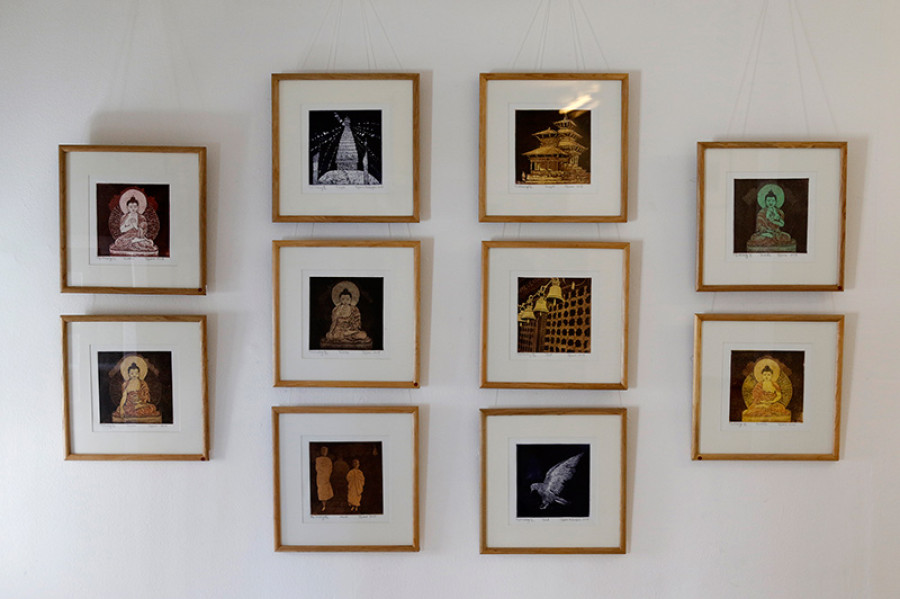Miscellaneous
Seduction in print
Seduction of Print Making, a group exhibition of prints, is an ongoing exhibit at the Siddhartha Art Gallery in Babarmahal. The show comprises 199 works by 21 printmakers as well as those by eight guest artists, better known for their facility with media aside from printmaking.
Rahul Dhakal
Seduction of Print Making, a group exhibition of prints, is an ongoing exhibit at the Siddhartha Art Gallery in Babarmahal. The show comprises 199 works by 21 printmakers as well as those by eight guest artists, better known for their facility with media aside from printmaking.
The diversity of individual approaches to the medium is partly reflected in the subjects of the prints which range from scenes of the city, rural landscapes, shared tangible/ intangible heritage, socio-political issues, personal life stories, and abstract forms.
Co-organisers of the exhibit and married couple, Uma Shankar Shah and Seema Sharma Shah, are also teachers of printmaking at the Central Department of Fine Arts in Tribhuvan University. In fact, the bulk of the exhibition is comprised of works by artists who had studied under them. Guest artists featured in the exhibit include Urmila Upadhya Garg, Pramila Giri, Manuj Babu Mishra, Shashi Bikram Shah, Batsa Gopal Vaidya, Kiran Manandar, Hriday Ballav Panday, and Lok Chitrakar.
All prints in the show are etchings. As such, the process of their making consists of using acid to cut into unprotected parts of a metal surface—often copper. The composition is then inked and transferred onto a piece of paper by way of a high-pressure printing press.
This process can be repeated many times and several hundred reproductions can be made using the same metal plate before the etched design wears off. As far as print making goes, the process of etching is one of the oldest and most prevalent—it was a popular technique among European ‘old masters’ and remains in wide usage among contemporary artists around the world.

The Shahs have been teaching printmaking for the last 20 years and are among the first to practice viscosity printing in Nepal. There is a neat trajectory of events that brought viscosity printing to Nepal. British artist Stanley William Hayter developed the method in the ’50s by combining relief printing and Intaglio printing techniques.
The process exploits varying viscosities of oil-based inks to lay multiple colours onto a single plate. Indian artist Deepak Bannerji, who studied under Hayter at the Paris studio, Atelier 17, went on to teach printmaking in Banares University where he imparted these ideas to students including Birendra Pratap Singh, Parmesh Kant Adhikari, and the printmaking couple, Uma Shankar and Seema Sharma Shah.
The two had met as students in Banares where they first began their lifelong commitment to printmaking and to each other. Over the course of their lengthy careers, the Shahs have taught printmaking to artists such as Anita Khanal Bhattarai, Bhishan Rajbhandari, Bidhata KC, Bipana Maharjan, Laxmi Prasad Koteja, Manju Khadka, Manju Shyaula, Rabita Kisi, Rukmani Shrestha, Samjhana Rajbhandari, Sangita Ghimire, Santosh Sigdel, Saurganga Darshandhari, Sujita Maharjan, Surendra Maharjan, Sushma Shakya, Tika Datta Dahal and Umesh Shah, whose works are included in this exhibition.
The show was put together by Uma Shankar, President of Printmaking Nepal—an organisation he and his wife founded in 2016 to propagate printmaking techniques in Nepal. The fact that 125 of the works in the exhibit have been sold speaks to the rising acceptance of print medium among Nepali patrons; however, Uma Shankar bemoaned the lack of interest shown by Nepali academic institutions towards printmaking.
Although Tribhuvan University’s printmaking department was established 20 years ago, the institution by and large remains apathetic to the discipline. According to Shah, the scant number of printing presses in the country has precluded the medium from truly flourishing here.
Uma Shankar runs two printing presses at his home studio in Swoyambhu, which is open for use by fellow artists and students. “My personal initiative has contributed to incremental change however printmaking can only make real headway with the support of large institutions…this year, 10 Nepali printmakers are invited to the Delhi Triennale, an unprecedented number that attests to the quality of their work…now it is time that Nepali institutions and buyers also take notice,” Shah said.
The show will run till April 20.




 16.09°C Kathmandu
16.09°C Kathmandu










